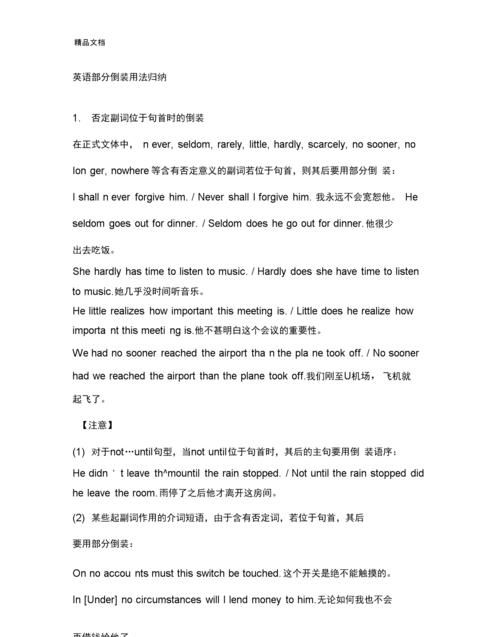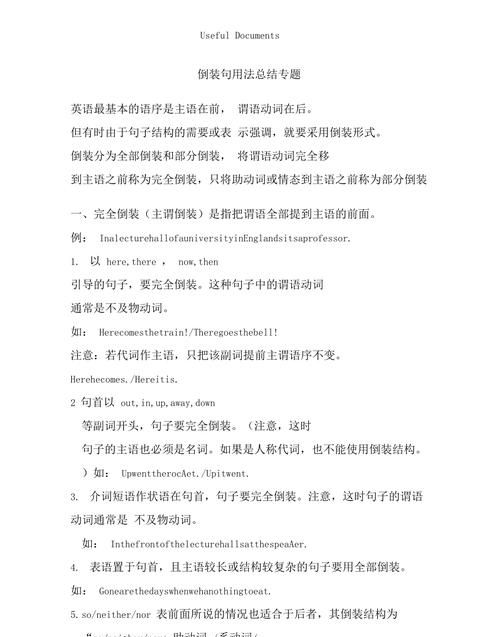本文目录
英语中倒装句的结构和用法浅析
一、语法知识
按 “主语+谓语”这种顺序排列的句子是陈述语序.如果排列顺序变为”谓语(或谓语的一部分)+主语” 就是倒装句.
(1) 倒装句的类型
1. 完全倒装: 整个谓语移至主语前面叫完全倒装.
Then came Mary and George.
Have you any books on that subject?
2. 部分倒装:只把助动词,系动词或情态动词放在主语之前叫部分倒装.
Has he gone to school? Is he your classmate?
Can you finish the work in three days?
(2) 倒装句的用法
1. 由于语法结构的需要而使用的倒装句
1) 用在疑问句中
Do you have a physiology class on Tuesday afternoon?
Why are you so angry with him?
注: 以疑问词或有疑问词修饰的名词作主语的疑问句不倒装.
Who was your geography teacher in Grade One?
2) 用在 “There be “结构中
There are different forms of energy.
There stands a high building by the river.
3) 用在以here , there , now , then 等副词开头的句子中, here and there强调地点,用来引起人们的注意,. 除then 开头的句子用过去时以外,其余均用一般现在时.
但是 如果主语是代词就不倒装.
Here is a letter for you. There comes the bus. Now comes my turn.
Here you are. There he comes!
4) 用在省略了if 的虚拟条件句中(把 were, had 或should移至主语前)
Were I ( If I were) in your place, I wouldn’t give it up so early.
Had I ( If I had ) know, I might have joined you in the discussion.
Should you (If you should) be interested, I have a book on the subject you might like to see.
5) 用在一些表示祝愿的句子中
Long live the friendship among the Asian peoples and sportsmen! Long live the king!
6) 直接引语的全部或一部分放在句首时,引述动词和他的主语有时倒装
“ You have made great progress this term.” Said our teacher.
“ Mr Crossett,” said my father. “ will you permit an old pupil to shake hands with you?”
引述动词的主语是代词,或谓语较厂,或引述动词后还带间接宾语时, 一般不用倒装句
“ What is your opinion?” I said.
“My father is a labour hero.” Xiao Wang told me.
“ Why did you join the Red Army? “ Chairman Mao asked me like a school teacher questioning a pupil.
7) 用在以so开头,表示谓语所述情况也适用于另一个人或另一事物的肯定句,表示”也一样” . 也这样”. 其句形为”So + be, have ,情态动词或助动词+ 主语”
He saw it , and so did I.
They can swim now, so can we.
注: 如果后面的句子只是重复前一句话的意思而不表示另一个主体,不用倒装句
It was hot yesterday. So it was.
8) 用在以neither, nor, no more 开头的句子中,表示” ---也不这样” 其句形为”neither, nor no more + be , have ,情态动词或助动词+ 主语”
The first one wasn’t good and neither was the second.
He doesn’t care much for sweets. No more do I .
2. 为了加强语气而使用的倒装
1) 用在以never, hardly, scarcely, not only, nor , seldom, little, rarely, nowhere, by no means, not until, hardly (scarcely)--- when, no sooner---than等表示否定意义或半否定意义的副词或其组开头中的句子中.
Never before have I met him.
Hardly did I think it possible.
Not only should we not be afraid of difficulties, but we should try our best to overcome them.
Not until midnight did it stop raining.
By no means will this method be satisfactory.
No sooner had they got to the plant than they started to work.
2) 用在做频度状语often, always, once, many a time, now and again, every other day, every two hours 等, 方式状语thus 及程度状语so等; 地点状语in the distance, in front of 等的几种副词或介词短语开头的句子中,常用倒装.
Often had I intended to speak of it.
Many a time has he helped me with my experiment.
So busy is he that he had no time to spare.
如果不是特别强调可以不倒装
3) 为了使句子更为生动,流畅,可把in, out , down, up, back, over, away, off之类的用做状语的副词放在句首, 采用完全倒装.句中的谓语动词多为行为动词,不及物.
In came the teacher and the lesson began.
Off went the horses.
Down came the hammer and out flew the sparks.
主语是人称代词时,一般只将副词放在句首,主语和谓语位置不变.
In he came and the lesson began.
4) 在副词only和它所修饰的状语一起放在句首时,用倒装语序.句形为 “Only +状语+部分倒装”
Only when the war was over in 1918 was he able to get happily back to work.
Only in this way can we learn maths well.
不放在句首不倒装, 不是状语是主语不倒装.
Only the teachers are allowed to use this room.
The aim was achieved only after a bitter struggle.
5) 用在强调表语的句子中
表语提前,不是为了强调,而是使句子平衡,避免头重脚轻.
Such was Albert Einstein, a simple man of great achievements.
Great has been our achievements since liberation.
如果主语是代词,而代词又无较长的修饰语修饰时,则仅把表语提前,系动词不提到主语前.
Terribly hot it certainly was.
A very reliable person he is .
6) 用在某些让步状语从句中
在正式的文体中,从属连词as 用于特殊词序可以表示although这种结构表示强烈的对照.
Tired as he was, he went on working.
Cold as it was, we went out.
Child as she is , she knows a great deal.

初一英语倒装句的归纳总结
摘要
倒装句是英语中常见的用法,意在说明被倒转部分的重要性,某些时候也起到强调作用或起到惊叹作用。英语倒装句可分为部分倒转和完全倒转,两种倒装句的用法大庭相径。
咨询记录 · 回答于2021-10-28
初一英语:倒装句
倒装句是英语中常见的用法,意在说明被倒转部分的重要性,某些时候也起到强调作用或起到惊叹作用。英语倒装句可分为部分倒转和完全倒转,两种倒装句的用法大庭相径。
用法一:表示方向、地点和时间的副词、介词短语置于句首用完全倒装。这种用法的倒转句,常见于口语对话中,英语书面语种较少出现这种用法。例句:here comes the bus(车到这来了),在这个例句中,主语“the bus”被后置,这就是为了强调车“来”的这一动作。用法二:表语+连系动词+主语(表语是形容词、介词短语、动词ing形式、过去分词等)。这种用法的完全倒装句可用于口头表达,也可用于书面表达。例句:such are the facts ,no one can deny them(这就是事实,没有人可以否认),该例句强调事实的重要性。
部分倒转用法一:only+状语、副词、介词短语、状语从句置于句首时,句子形成部分倒转结构。例句:only when he returned did we find out the truth(只有他回来了,我们才能弄清事实),在这个例句中,倒转部分强调“他”回来的重要性,这种用法常见于书面。用法二:固定句式结构的倒转。这种固定结构种类较多,常见的有(1)so+be动词、助动词或情态动词+主语。例句:we love having lots of friends,so do those with disabilities(我们钟情于拥有很多朋友,残疾人同样如此)。(2)虚拟条件句中含有hadwereshould等词时,句子形成部分倒转,同时虚拟条件句的引导词if可以被省略。例句:were i you, I would take his advice(如果我是你的话,我会接受他的建议)。
怎样快速领悟倒装句的用法。请主谓宾等用生活中正常用的字词写✍在括号里,防止孩子连主谓宾都不是太熟练。
初一
单词短文都背的挺好的,就是写句子不行
倒装句的用法倒装句就是将正常的陈述语序加以变化,主要作用是强调被提前的部分,倒装句可分为全部倒装和部分倒装两种:1、全部倒装谓语动词提前至主语之前为全部倒装。2、部分倒装助动词或情态动词提至主语之前,谓语动词位置不变,即为部分倒装。3、否定词提前倒装,否定词用于句首时,句子应进行部分倒装。否定词常用的有:Not only…(but also),Not until(直到…..才),No sooner….(than)(一…..就),Never/ Rarely/Seldom,Hardly/Scarcely,Few/Little,Neither/Nor (也不),At no time,Under no circumstances(决不),On no account (决不),In no way,其中not only, no sooner, hardly, scarcely 分别和but (also), than, when搭配使用,需注意:后一组词之后的部分不进行倒装,只有否定词之后的部分倒装。4、副词提前倒装副词提至句首引起倒装,可分以下几种情况:●only + 副词(when, before, if, after等)或only+介词状语(由in, under, by, on, after等引导)提前,必须部分倒装。例句:Only then did he realize how stupid he had been.●often, such, so等副词提前,部分倒装。注意,so的另一种倒装是表示“也…”例句:California relies heavily on income from crops, and so does Florida.加利福尼亚过多的依赖于来自农作物的收入,佛罗里达也是这样。●neither,nor的倒装例句:He can't dance, neither/nor can I.= I can't, either.他不会跳舞,我也不会。●in, out, down, up, away, off, here, there, over等副词提前,全部倒装。
有没有更通俗易懂的方法?请指点迷津
能够使孩子开窍的思路
1.倒装句之全部倒装全部倒装是只将句子中的谓语动词全部置于主语之前。此结构通常只用与一般现在时和一般过去时。常见的结构有:(1)here, there, now, then, thus等副词置于句首, 谓语动词常用be, come, go, lie,run。例如:There goes the bell.Then came the chairman.Here is your letter.(2)表示运动方向的副词或地点状语置于句首,谓语表示运动的动词。Out rushed a missile from under the bomber.Ahead sat an old woman.注意:上述全部倒装的句型结构的主语必须是名词,如果主语是人称代词则不能完全倒装。例如:Here he comes.Away they went.2.倒装句之部分倒装部分倒装是指将谓语的一部分如助动词或情态倒装至主语之前。如果句中的谓语没有助动词或情态动词,则需添加助动词do,
请问写好句子有没有能够让孩子恍然大悟的秘诀
亲,可以+V信,详细v信说!一八0五0九000六七。刚手机没电!

英语倒装句怎么使用
英语倒装句的用法
倒装(Inversion)是一种语法手段,用以表示一定句子结构的需要和强调某一句子
成分的需要。英语的最基本结构是主、谓结构,倒装就是将这种比较固定的结构
加以颠倒。
倒装有两种:将主语和谓语完全颠倒过来,叫做完全倒装(Complete
Inversion)。如:In came a man with a white beard.
只将助动词(包括情态动词)移至主语之前,叫做部分倒装(Partial
Inversion)。如:Only once was John late to class.
英语句子的倒装一是由于语法结构的需要而进行的倒装,二是由于修辞的需
要而进行的倒装。前一种情况,倒装是必须的,否则就会出现语法错误;后一种情
况,倒装是选择性的,倒装与否只会产生表达效果上的差异。下面本文就拟从其修
辞功能谈谈倒装句的用法。
一、 表示强调:
倒装句最突出、最常见的修辞效果就是强调,其表现形式如下:
1. only +状语或状语从句置于句首,句子用部分倒装。
例1:Only in this way can you solve this problem. 只有用这种方法,你
才可以解决这个问题。
例2:Only after he had spoken out the word did he realize he had
made a big mistake.只有当他已经说出那个字后才意识到自己犯了个大错误。
2. not,little,hardly,scarcely,no more,no longer,in no
way,never,seldom,not only,no sooner等具有否定意义的词或词组位于句首,句
子用部分倒装。
例1: No sooner had I got home than it began to rain. 我刚到家就下
起了雨。
例2: Seldom do I go to work by bus. 我很少乘公共汽车上班。
3. so / such...that结构中的so或such位于句首可以构成部分倒装句,表示
强调so /such和that之间的部分。
例1:So unreasonable was his price that everybody startled. 他的要
价太离谱,令每个人都瞠目结舌。
例2:To such length did she go in rehearsal that the two actors
walked out. 她的彩排进行得那么长,以致于那两个演员都走出去了。
以上各例都用倒装语序突出了句首成分,其语气较自然语序强烈,因而具有极
佳的修辞效果。
二、 承上启下
有时倒装可把前一句说到的人或物,或与前一句有联系的人或物在下一句紧
接着先说出来,从而使前后两句在意思上的关系更加清楚,衔接更加紧密,起到承
上启下的作用。
例1: They broke into her uncle's bedroom and found the man lying
on the floor, dead. Around his head was a brown snake. 他们破门进入她
叔叔的卧室,发现他躺在地板上死了。一条棕褐色的蛇缠在他头上。
例2: We really should not resent being called paupers. Paupers we
are, and paupers we shall remain. 我们确实不应因为被称作穷光蛋而愤愤不
平。我们的确是穷光蛋,而且还会继续是穷光蛋。
三、 制造悬念,渲染气氛
在新闻或文学创作中,有时为了内容的需要,或是为了强调,作者常常运用倒
装来制造悬念,渲染气氛。如:
Hanging on the wall was a splendid painting. 墙上挂着一幅精美的图
画。
再如朗费罗(Longfellow)《雪花》中的一节:
Out of the bosom of the Air,
Out of the cloud-folds of her garments shaken,
Over the woodlands brown and bare,
Over the harvest-fields forsaken,
Silent, and soft, and slow,
Descends the snow.
在这一节诗里 ,诗人就富有创意地运用了倒装。在前五行中 ,诗人堆砌了七
个状语,状语连续出现而主语和谓语却迟迟未露 ,造成一种悬念效应。全节读
罢 ,读者才对诗歌的主题恍然大悟 ,因而收到了不同凡响的艺术效果。
四、 平衡结构
英语修辞的一个重要原则是尾重原则,即把句子最复杂的成分放在句尾以保
持句子平衡。在语言使用中为了避免产生头重脚轻、结构不平衡的句子,我们常
采用倒装语序。
1. 以作状语的介词短语开头:当主语较长或主语所带修饰语较长时,为了使
句子平衡,常将状语置于句首,句子用完全倒装语序。
例1:A. To the coal mine came a com-pany of PLA soldiers with
orders from the headquarters to rescue the trapped miners.
B. A company of PLA soldiers came to the coal mine with orders
from the headquarters to rescue the trapped miners.
一个连队的解放军战士来到了那座煤矿,奉司令部之命解救受困的矿工。
例2:A. On the ground lay some air conditioners, which are to be
shipped to some other cities.
B. Some air conditioners lay on the ground, which are to be
shipped to some other cities.
地上放着一些空调,等着用船运到其他城市去。
从例句中可看出, 采用倒装语序的A句结构平衡稳妥 ,读起来自然流畅,而采
用自然语序的B句结构零乱, 读起来也别扭。因而,在主语较长时就应采用倒装语
序以取得理想的表达效果。
2. 以表语开头的句子:有时为了把较长的主语放在后面,须将表语和谓语都
提到主语前。如:
Such would be our home in the future. 我们将来的家就是这个样子。
3. 以副词here , there开头的句子,也采用完全倒装来保持句子平衡。如:
Here is the letter you have been looking forward to. 你盼望已久的
信在这儿。
五、 使描写生动
有时为了使叙述或描绘更加生动形象,增加语言效果,可将表示方向的副词
(如:down, up, out, in, off, on, away等)或拟声词(bang, crack等)置于句
首,句子采用全部倒装的语序(主语为人称代词的句子除外)。如:
Up went the rocket into the air. 嗖地一声火箭就飞上天了。
Down jumped the criminal from the third floor when the policeman
pointed his pistol at him. 当警察把手枪瞄准那个罪犯时,嘭地一下他就从三
楼跳了下去。
Boom went the cannon! 轰隆一声大炮开火了!
Bang came another shot!砰!又是一声枪响!
以上句子简洁明快 ,生动逼真地描述了有关动作 ,令我们一览此类倒装的风
采。但这种倒装句的修辞功能在语段中可以体现得更为清楚。
“Stop thief! Stop thief!” There is a magic cry in the sound.
The tradesman leaves his counter, ... Away they run, pell—mell,
helter—skelter, yelling—screaming, ...
“Stop thief ! Stop thief !” The cry is taking by a hundred
voices, ... Away they fly, splashing through the mud, up go the
window, out run the people. ( Dickens )
作者在第一段和第二段中分别用副词away, up和out位于句首引出四个倒装
句Away they run , Away they fly, up go the window , out run the
people。从而制造出一种紧张、急促的气氛 ,生动地刻画了一个紧张、混乱的捉贼场面。

倒装句初中英语结构
倒装句是英语中常见的用法,意在说明被倒装部分的重要性,某些时候也起到强调作用或起到惊叹作用。
完全倒装
用法一:表示方向、地点和时间的副词、介词短语置于句首用完全倒装。这种用法的倒装句,常见于口语对话中,英语书面语中较少出现。例句:Here comes the bus(车到这来了),在这个例句中,主语“the bus”被后置,这就是为了强调车“来”的这一动作。
用法二:表语+连系动词+主语(表语是形容词、介词短语、动词ing形式、过去分词等)。这种用法的完全倒装句可用于口头,也可用于书面表达。例句:Such are the facts ,no one can deny them(这就是事实,没有人可以否认),该例句强调事实的重要性。
部分倒装
用法一:only+状语、副词、介词短语、状语从句置于句首时,句子形成部分倒装结构。例句:Only when he returned did we find out the truth(只有他回来了,我们才能弄清事实),在这个例句中,倒装部分强调“他”回来的重要性,这种用法常见于书面。
用法二:固定句式结构的倒装。这种固定结构种类较多,常见的有:
(1)so+be动词、助动词或情态动词+主语。例句:We love having lots of friends, so do those with disabilities(我们钟情于拥有很多朋友,残疾人同样如此)。
(2)虚拟条件句中含有hadwereshould等词时,句子形成部分倒装,同时虚拟条件句的引导词if可以被省略。例句:Were I you, I would take his advice(如果我是你的话,我会接受他的建议)。

以上就是关于初中英语倒装句的用法归纳 ,英语中倒装句的结构和用法浅析的全部内容,以及初中英语倒装句的用法归纳 的相关内容,希望能够帮到您。

